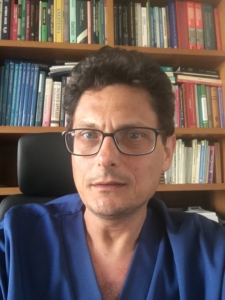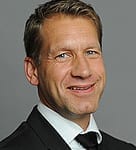Congress Newsletter 2021
EA21 Newsletter: ESAIC President Elect Edoardo De Robertis: looking forward to a post-pandemic future

Q: Congratulations on your nomination as President Edoardo. Although, of course, you have known for some time that you would be our next President, could you tell us how it feels to be given the responsibility for overseeing such a large and successful society as ESAIC?
A: I am very honoured and proud to have been elected, and I wish to express again my thanks to all the colleagues that have supported my vision and aim for the further development and appreciation of ESAIC as the outmost worldwide recognised society of anaesthesia and intensive care! Over the last years, as a member of the Board of Directors, I have been having the great privilege to actively participate in the most important strategic decisions and recent significant undertakings of the society, including the name change. These experiences have given me a deep knowledge of ESAIC’s complex organization, mission and vision, and the way society runs. I feel ready and very eager to start with great energy and dedication my presidency, but to be honest I also feel the burden of the many responsibilities, commitments and challenges ahead.
Q: Our delegates will be keen to know about you and how your career has developed over the years. So, take us back to the start. What made you become a doctor, and then specialise in anaesthesia?
A: I think I have always loved medicine and already as a teenager it was very clear to me the idea to become a physician. I graduated in 1992 from the University Federico II of Napoli, after having spent two semesters in Brussels, as one of the first Erasmus students. I then chose anaesthesiology, attracted by the fact that it is the only speciality that gives a holistic view of patients of all ages and allows physicians to care for people in the most delicate and vulnerable moments. Anaesthesiologists deeply and compassionately care, endlessly spending all their efforts for patients’ safety. I was particularly fascinated by the critical medicine and emergency aspects of the speciality and by the possibility to research in the field of applied physiology and technological innovations.
Always in Napoli, at the University Federico II, under the mentorship of Prof. Rosalba Tufano, I soon started my academic and professional carrier. Then 3 years ago I moved to the University of Perugia where I am now the director of the Department of Anaesthesia and ICM at the University Hospital and the director of the training program in Anaesthesia, Intensive Care, and Pain Medicine.
My academic and clinical background, which saw me over the years research and practice both in ICU and operating theatres, made me grow up in a proud anaesthesiologist/intensivist who sincerely believes in the importance of the development and maintenance of all the competencies needed to satisfy the many requirements of our unique speciality and complex clinical role.
Q: Have you spent most of your career working in Italy? Where else did you train/spend time?
A: I had the opportunity to take a PhD in clinical physiology at the University of Lund, Sweden, where I studied and researched for more than 3 years under the supervision of Prof. Bjorn Jonson, one of the fathers of modern mechanical ventilation. It was a very exciting time of my research career, which remains deep in my heart. Then, of course, I spent most of my career working in Italy but always keeping strict research relationships with many important institutions in Europe.
Q: What are some of the studies you have been involved in over the years that you have been most proud of?
A: Well, as I mentioned before, my studies and research in Sweden fascinated me. I researched in complex animal models new methods for the automatic recordings of respiratory mechanics and the development of tools for protective ventilation in ARDS patients, such as a method for the aspiration and replacement of dead space, which we called ASPIDS. Then back in Italy, I started to research these technologies and methods in critically ill patients. All these experiences have been published over the years in high ranked journals. So mechanical ventilation is the field of research in my heart, but in the subsequent years, I have been also involved in research in other fields, as obstetric anaesthesia and massive bleeding, collaborating in the development of well-renewed guidelines.
Q: What would you like to achieve during your years as President of the Society?
A: the change of the society name has been a milestone in the story of the society. The pandemic has highlighted the anaesthesiologists’ central role as leader in hospital’s organization and decision-making, with responsibility in critically ill patients care. Moreover, over the last months, we have shown great capacity to adapt. That’s why it is now more than ever important to further develop the Intensive Care project and promote, sustain and spread the relevance of our complex speciality increasing our visibility and influence. Research, education and scientific aspects should be better harmonised creating a strong network of colleagues in ESAIC, linked to each other by a firm and willing commitment to foster the appreciation and respect of ESAIC as the greatest inclusive community of professionals involved in anaesthesia, intensive care, critical emergencies and pain. ESAIC is a community of wonderful, knowledgeable, and passionate colleagues that are eager to offer their best efforts for our society. This makes me sure that all together we will be able to bring ESAIC forward towards new horizons. In continuity with the great work done in the last years, the goals I have set for the next months are several.
Reassessment of the scientific sub-commission, which I see as platforms of aggregation of outstanding researchers, as incubators for innovations, and as a flywheel for the promotion of research and dissemination of knowledge.
Further growth of the A-CRO in the infrastructure of reference for the design and steering of research projects of the anaesthesiologist/intensivist community.
Continue with the development, endorsement and sustainment of outstanding trials and studies, as for the recent ENVISION and COVend projects, financed with more than 10 million Euros within the European Commission’s Horizon 2020 program, in which ESAIC is fully involved with a consortium of several European clinical centres.
High-quality training, education shall be a must as well as the development and maintenance of what I would call “professional advanced competencies” in all fields of our speciality.
Patient safety is a pillar for our society and it is mandatory the maintenance of the highest standards of quality of care in all fields of our profession by creating new networks with institutions, societies, and stockholders for a common patient safety approach, and enhancing the already existing ones, such as the European PBM network; and a robust and uniform system of examination and certification.
Q: Of course, we all hope that we will return to in-person meetings, in hybrid form, in 2022. How are you yourself feeling about the COVID pandemic? Has the new omicron variant set us back somewhat? Or must we learn to live with the disease and whatever happens in the future?
A: the pandemic is a tragedy that is still raging throughout Europe and the whole world. The last variant has added further apprehension, but I am optimistic in the sense that I am sure we will be able to control the pandemic in the next months and return to a “normal” life, but I am not sure that our lives and profession will be as before. During the pandemic, the world has changed! The economy has been changing. We have learned to differently live and work, but not all changes can be considered negative. The way we can easily and more familiarly meet virtually will help us in being constantly and more profitably able to be connected and better organise and optimise our work. For sure we will come back to meet face-to-face, and share the joy of the company. I foresee a future in which we will alternate short virtual meetings, with the more attractive and human face-to-face meetings.
Q: What message of goodbye and thanks would you like to give all our delegates who have attended Euroanaesthesia 2021?
A: the situation in Europe has forced us to take the sad decision to have Euroanaesthesia in Munich only virtual. We have lost the possibility to meet each other and network, but, thanks to the huge, enormous efforts of the wonderful staff in our headquarters in Brussels, it was possible to offer a great virtual meeting with an impressive scientific program. I thank all of the ESAIC members that have participated, they have shown how our community is eager to exchange ideas and improve their knowledge and skills, no matter what. I am looking forward to meeting all of you next June in Milan.
Q: All the above is work stuff! Tell our delegates how you like to relax when you are able to?
A: I hope to find the time to relax in the near future. I have a wonderful family. My beloved wife and daughters are my daily inspiration and with them, I will share all the time, not at work. As for hobbies, I love to play the guitar and sail.
Thanks, Edoardo and we sincerely hope to see you address the Euroanaesthesia 2022 meeting in person!
Read More of our special newsletter covering our virtual congress









